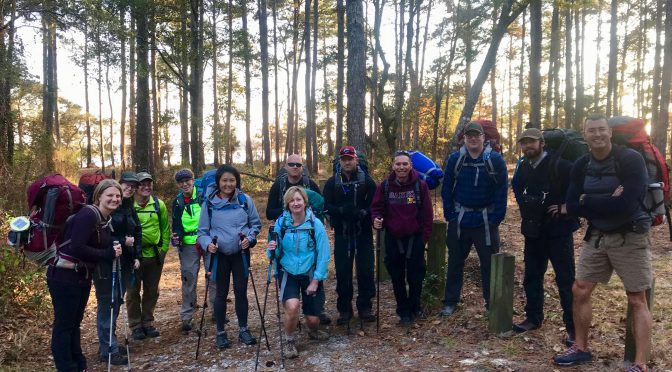On Saturday morning’s GetHiking! hike at Umstead State Park, half the number of hikers who signed up showed up. No mystery there: it was cold.
What is a mystery is why so many hikers let a little thing like freezing temperatures keep them off the trail. As we may have mentioned (just last week, in fact), we love a winter hike: among other things, there are fewer people, fewer bugs, and it’s blissfully quiet. Yet too many people miss out because they don’t know how to dress. Let’s solve that problem here and now.
The top
Base layer (top) Your first line of defense, and probably the most important article of clothing in your arsenal, is the base layer. It should be long sleeve and lightweight, typically either wool or a synthetic, but definitely not cotton. The key role of the base layer is to wick sweat from your skin, then quickly evaporate that sweat so it doesn’t have a chance to cool and chill your body. A nice synthetic or wool will, at the same time, keep the heat your body generates from escaping.
Insulating layer Generally, a slightly heavier layer that helps create a pocket of air warmed by your body between it and the base layer. Again, wool or synthetic material is preferable. How heavy this layer should be depends upon how cold it’s going to be. Unless it’s going to be especially cold (in the 20s or lower) and windy, this will also be the layer you wear on the outside; thus, we prefer this layer have a pocket to store a phone or camera. One other feature to look for: a zipper, preferably a quarter pull, which comes in handy in helping to regulate your body heat (e.g., keep the zipper down to vent heat when you’re chugging uphill, zip up when you’ve stopped or are on a more leisurely downhill.
Outer shell Especially important when the weather gets cold (20s) and there’s wind. An outer shell is generally a slick fabric that will shed rain and wind. A good outer shell will also have a vent system to keep condensation from building inside. Zippers in the armpits is one popular option as is mesh under the arms and along the side of the torso.
The bottom
Base layer (bottom) Legs tend not to be as susceptible to cold as the torso, but if your legs are cold-sensitive, follow the advice for the upper base layer and get synthetic or wool long johns. Whether you need a base layer on the bottom also depends on the type of hiking pants you have … .
Pants We tend not to give as much attention to pants in winter as we might. To be honest, I can’t remember the last time my legs were cold, and it’s not something I give as much thought to for a winter hike. Eighty percent of the time in winter I wear Kuhl Renegade pants, which are relatively lightweight and made of a softshell fabric that does a good job of blocking the wind. However, if the temperature will be in the 20s or lower I go for my Stio Pinedales, which look like hiking pants but actually are more like ski pants. They’re a tad heavier than my Kuhls, they have a tighter weave and they’ve got spandex (in combination with nylon and polyester). Pricey, but great for cold weather hiking.
Socks You have no excuse for cold feet these days, not with the profusion of technical socks available. Without drilling too deep, you’ll find lightweight socks for summer, medium for spring and fall, and heavier socks for winter. Heavy, but not heavy like the wooly monsters that were de rigueur for winter hiking a couple decades ago. They’re a tight weave but aren’t bulky, and you needn’t wear sock liners. Quality hiking socks can be expensive, but the snug, warm fit is worth it. Plus, some brands now offer lifetime guarantees.
Shoes/boots Lots of folks hike in trail runners, but in really cold weather — especially really cold weather where there’s the possibility of stream crossings and otherwise getting your feet wet — hiking shoes and boots are recommended. And not those summer hikers sporting lots of mesh: warm socks can only do so much.
The extremities
Hats and gloves Hats and gloves are your most efficient way to manage heat. Start heating up on a climb? Pluck your hat and tuck it in a pocket. Getting a chill? Grab those gloves out of your pack’s side pocket and warm up. Wool hats are best; you can get away with lightweight knit gloves on cool hikes, a glove employing a wind breaking shell and a liner is required for really cold weather.
Don’t miss out on winter’s many wonders. Layer up and join us on the trail.
Happy Trails,
Joe
More info
- Why hike? What’s so great about hiking in winter? In case you were absent last week, here’s our case.
- Winter hiking tips. For tips on hiking strategy in the cold, check out this previous post, “Don’t Let the Cold Clip Your Hiking Wings”
- What to buy? Looking for specific examples of the above-mentioned layers? Check this blog we wrote for our friends at Great Outdoor Provision Co.
- What to buy on the cheap? Don’t want to spend a fortune on layers? You don’t have to. The prices in this post “Cold? Layer Up, Take a Walk” may be slightly dated, but the concept remains the same.
- Learn more about Stio Pinedale pants here.
- Learn more about hat and glove options here.
